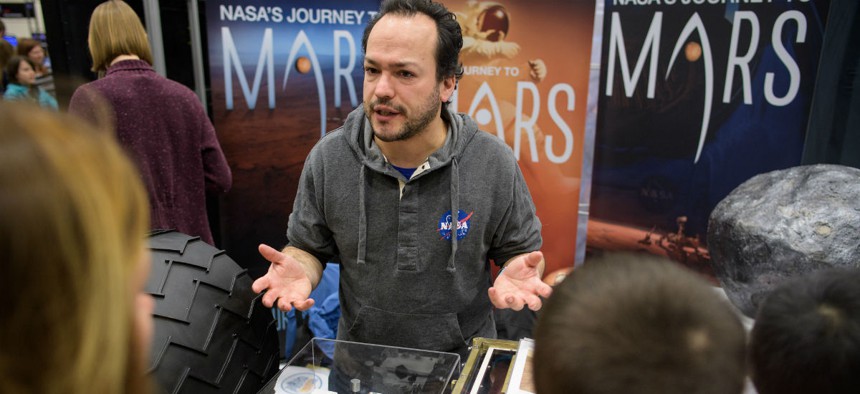
A NASA employee discusses the Mars Science Laboratory mission at the USA Science and Engineering Festival on April 6. Joel Kowsky/NASA
Agencies Must Change Their Recruiting Strategies
Only 42 percent of federal employees believe their agencies recruit people with the right skills.
President Trump recently released a management agenda that calls for developing a 21st century federal workforce—one more closely aligned with agency missions and with the specialized skills needed to meet the evolving demands of the American public.
It won’t be easy.
A recent Office of Personnel Management workforce report found that 83 percent of agencies believe that staffing shortages hamper their ability to meet mission requirements and that they are both unprepared to fill current vacancies and have not developed clear plans to recruit and retain top talent. In OPM’s 2017 Federal Employee Viewpoint Survey, only 42 percent of respondents said their agencies recruit people with the right skills.
At the same time, recruitment budgets in most agencies have remained steady or decreased. Limited resources means that achieving the White House’s workforce goals will require agencies to find innovative ways to recruit and hire top talent, especially in areas where the government has the greatest skill gaps. These include cybersecurity experts, economists, human resources specialists, auditors, acquisition specialists, and those with backgrounds in science, technology, engineering and mathematics.
New Strategies
In response to and in anticipation of these ongoing challenges, a number of agencies are taking fresh approaches to attract and hire talented employees and meet mission needs.
Through its Entrepreneurs-in-Residence program, the Health and Human Services Department has identified opportunities where projects or programs can benefit from expertise outside of government. Under this initiative, the department has reached out to private sector experts willing to perform a 13-month tour of duty to help meet a specific goal. The program allows HHS to draw from a flexible talent pool of experts and capitalize on knowledge and experience it does not have internally.
“We look for people who have a passion for solving problems and have the rare combination of confidence and humility which allows them to drive a project forward,” said Will Yang, interim program director of the Entrepreneurs-in-Residence program.
Projects that benefit from this approach have included modernizing the department’s data systems, improving Medicare beneficiary access to health information, and transforming electronic tracking and transport of donor organs through the nation’s organ transplant system.
In another case, a large intelligence agency realized its workforce was aging as it struggled to attract and retain entry-level talent. To realign the workforce, the agency reviewed its workforce structure and implemented major changes to recruiting and hiring by focusing on lower-level positions. As part of this initiative, the agency developed and integrated analytic tools and strategies to track, report and monitor the complicated, cross-division steps and approvals to more swiftly move candidates through the recruiting and hiring process.
NASA is embracing talent acquisition strategies already commonly practiced by the private sector and is launching a new careers website as part of a larger effort to enhance its employer brand.
Space agency officials analyzed data from social media, their Federal Employee Viewpoint Survey and conducted employee focus groups to glean insights about what made the agency a great place to work. These efforts resulted in an employer value proposition that is woven through new recruitment materials highlighting employees’ positive work experiences and exciting opportunities for the future.
NASA also developed a corporate LinkedIn page where targeted candidate pools, such as engineers or scientists, can find personalized information about what it’s like to work at NASA in their field of expertise. This has helped NASA grow its social media engagement with recruitment-related content over previous years.
The Agriculture and Treasury departments are offering special pay incentives, allowing them to compete effectively for a limited pool of highly desirable STEM candidates. Other agencies have built partnerships with colleges and universities to create talent pipelines for specialized fields, and some have held job fairs and made use of special pay, relocation and hiring flexibilities to attract and hire qualified people.
The days when federal agencies could simply post vacancies on USAJOBS and wait for qualified applicants to apply are long gone. The ability to recruit and hire talented employees is a central element of the president’s plan to transform and modernize government. Agencies can rise to the challenge, but it will require innovative strategies and approaches, such as broadening current recruitment efforts and moving from a passive to a proactive approach.
Meroe Park is the Partnership for Public Service’s executive vice president, overseeing the organization’s programs and its work with federal agencies. Abby Cashman is a principal at Booz Allen Hamilton and is one of the firm’s leaders in human capital and workforce planning. For ongoing discussion around the federal workforce, visit Booz Allen and the Partnership for Public Service and follow online at #PoweringGov.






